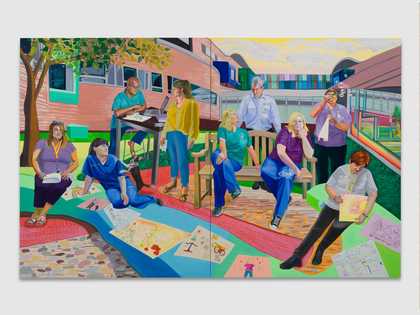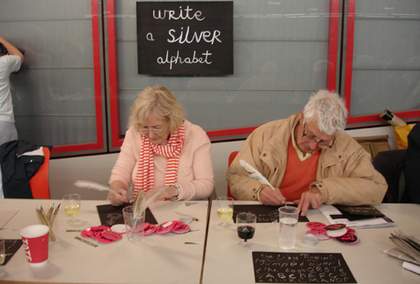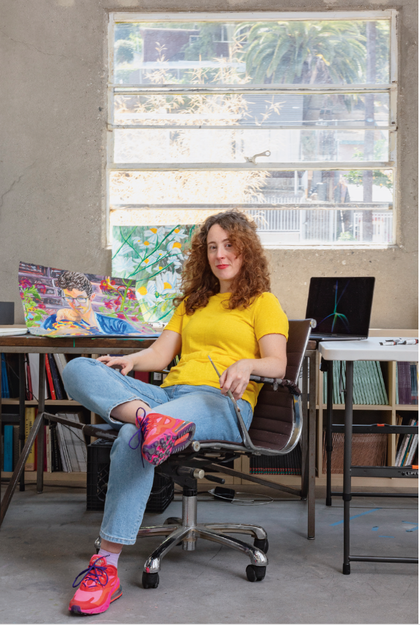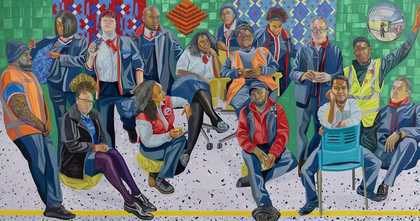
Aliza Nisenbaum London Underground: Brixton Station and Victoria Line Staff 2018-19 © Aliza Nisenbaum. Courtesy the artist and Art on the Underground, London; Mary Mary, Glasgow; Anton Kern Gallery, New York
Mexican-born painter Aliza Nisenbaum is best-known for her bright, large-scale portraits of people and community groups. We explore the artist’s work and their approach to figurative painting …
1. She uses art as a form of social practice
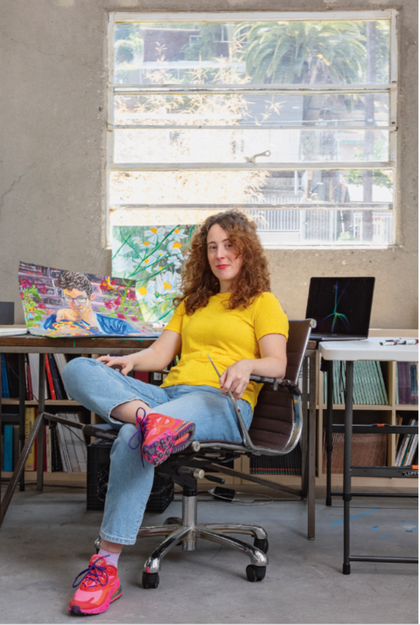
Aliza Nisenbaum in her studio in Los Angeles, August 2020, photographed by Joshua White © Joshua White / JWPictures.com
In 2012, Nisenbaum had a residency at artist Tania Bruguera’s Immigrant Movement International. The community-based project creates a space where immigrants can engage with contemporary art in an empowering way. Nisenbaum taught English to Mexican and Central American immigrants as part of the project, and asked to paint her students as a way of getting to know them better. As she describes;
It was through teaching that I learned about social practice – art that has a social purpose. [...] I’d take these mostly undocumented migrants, mainly from Mexico and Central America, to the Met, and art became a springboard to talk about all sorts of other things. And that eventually led to the portraits.
2. Her paintings focus on communities
Nisenbaum’s work mainly shows people, in both groups and as individuals, who are historically underrepresented - due to gender, nationality, race, class or sexual preference. This has included painting often marginalised individuals who work for Transport for London, the NHS and museum security staff. Historically portraits typically depict wealthy and powerful individuals. Nisenbaum paints people who are often overlooked by society, but by highlighting them in this way, she makes it clear how important they are. Nisenbaum has said that she is influenced by Mexican muralists such as Diego Rivera, and their depiction of social history.
3. She paints her portraits in an intimate way
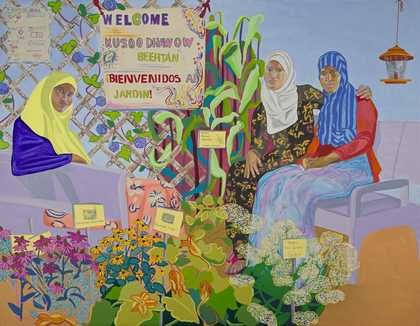
Aliza Nisenbaum Nimo, Sumiya, and Bisharo harvesting flowers and vegetables at Hope Community Garden 2017 © Aliza Nisenbaum. Courtesy the artist and Minneapolis Institute of Art, Minneapolis, Anton Kern Gallery, New York
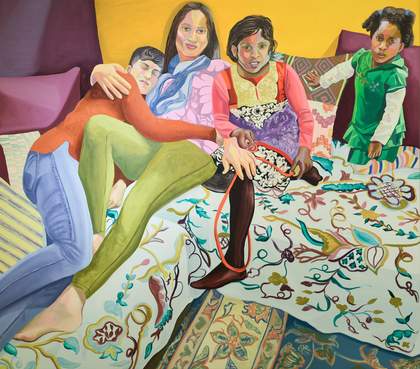
Aliza Nisenbaum Susan, Aarti, Keerthana and Princess, Sunday in Brooklyn 2018 © Aliza Nisenbaum. Courtesy the artist and Anton Kern Gallery, New York
The connection with sitters is a very interesting part of the work – and very much outside my control. It’s unpredictable what somebody’s going to bring to a sitting. – Aliza Nisenbaum
Aliza Nisenbaum typically paints from life and spends long periods of time with her subjects. The sitters [those who sit to have their portrait painted) may be reading, having a snack, watching a film or chatting as Nisenbaum paints them. During this process, the sitters often share personal thoughts and open up about their lives. This openness allows Nisenbaum to capture the subjects’ personalities and lived experiences. This also enables the artist to take a collaborative approach to the work – empowering her subjects to make choices about how they are represented and asking for their feedback throughout the process.
One of the outcomes of the slow process of painting from observation is that I get to know these families through the hours we spend together. [...] I discover in this process moments of privacy, interiority, and deep absorption for both my sitters and myself.
Aliza Nisenbaum
4. Colour is key to their work

Aliza Nisenbaum in her studio. Photography by Ryan C. Spencer, courtesy the artist and Anton Kern Gallery, New York
Nisenbaum paints small areas of sharp and contrasting colours next to each other to show the variety of tones which make up her sitter’s skin. Warm yellows and shades of reds are used for the sitter’s face, while cool blues and purples indicate shadows on their skin. As the artist explains,
You have to pay close attention to the subtle nuance of every little character in their face, and colour is something that is very contingent. Everyone perceives it differently and it’s a myth that even within a particular race there’s a seamless colour. To me, that’s like a metaphor of how nuanced identity is. We’re very multifaceted in terms of our identities.
5. She uses objects and settings to reflect personal stories
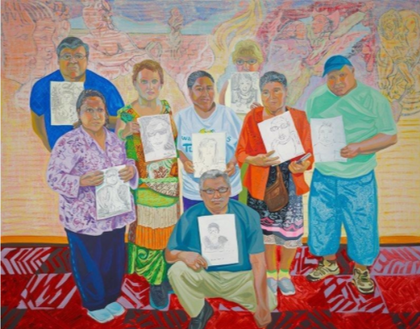
Aliza Nisenbaum Wise Elders Portraiture Class at Centro Tyrone Guzman with En Familia hay Fuerza, mural on the history of immigrant farm labor to the United States 2017 © Aliza Nisenbaum. Courtesy the artist and Minneapolis Institute of Art, Minneapolis, Anton Kern Gallery, New York
I see these compositions as private places for dreaming, where figures become embraced by the spaces surrounding them. – Aliza Nisenbaum
Rather than depicting her sitters in an overly realistic way, they are what Nisenbaum calls ‘a montage of points in time’. Her subjects are shown in pattern-dense interiors and object-filled scenes, often inspired by their own homes. Nisenbaum has described these backgrounds as ‘an extension of the people’s personality, their biography’. The mix of rich interior and personal items seen in Nisenbaum’s work tell stories about the sitters and symbolise the insight the artist has into their lives and experiences.
See Aliza Nisenbaum at Tate Liverpool 15 December 2020 – 27 June 2021.

